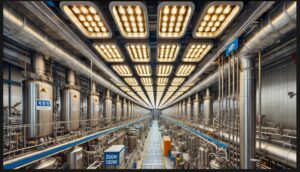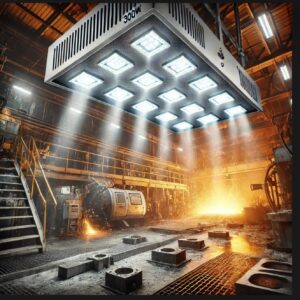4. Lower Maintenance Risks and Costs
- Reduced Need for Frequent Replacements: Traditional lighting systems often require frequent replacement due to the harsh conditions they face, leading to safety risks during maintenance work. Replacing bulbs in high-temperature environments can expose workers to dangerous conditions. High-temperature-resistant LEDs last much longer, reducing the need for frequent maintenance and minimizing worker exposure to potential hazards.
- Decreased Downtime for Maintenance: Since high-temperature LEDs have a longer lifespan and require fewer replacements, there’s less need for workers to spend time maintaining or replacing lighting fixtures, leading to less downtime and fewer risks associated with maintenance work. This is especially critical in industrial environments where uptime is essential for productivity.
5. Energy-Efficiency and Safety Synergy
- Lower Heat Emission for Safer Workplaces: One of the significant benefits of high-temperature LEDs is their ability to emit much less heat compared to traditional lighting technologies. Reducing the overall heat load in a facility not only helps improve energy efficiency but also contributes to a safer work environment. By generating less heat, LEDs help maintain lower ambient temperatures, reducing the strain on ventilation and cooling systems and lowering the risk of heat-related accidents.
- Sustainable and Eco-Friendly Lighting: High-temperature LEDs are energy-efficient, consuming less power than traditional lights. This reduces the environmental impact and lowers operational costs. Additionally, LEDs do not contain hazardous substances like mercury, making them safer to use and dispose of in industrial settings.
High-temperature-resistant LED lighting solutions offer unmatched safety and stable performance in extreme heat environments. Their ability to withstand high temperatures, provide consistent light output, and reduce maintenance needs makes them the ideal lighting choice for industries like float glass manufacturing, where worker safety and operational efficiency are paramount. By reducing the risk of fire hazards, improving visibility, and enhancing overall workplace safety, high-temperature LEDs ensure that critical operations run smoothly, cost-effectively, and safely.

IV. Key Features of High-Temperature LED Lighting Solutions
Heat-resistant components (ceramic substrates, aluminum heat sinks, high-temperature coatings)
To ensure reliable and long-lasting performance in extreme heat environments, high-temperature-resistant LED lighting solutions incorporate a variety of heat-resistant components. These components are designed to withstand intense heat, dissipate excess thermal energy, and maintain the structural integrity of the lighting fixture. Key components include ceramic substrates, aluminum heat sinks, and high-temperature coatings, which work together to ensure the lighting remains stable, efficient, and safe in harsh industrial conditions. Here’s an overview of these essential heat-resistant components:
1. Ceramic Substrates for Efficient Heat Transfer
- Heat Resistance: Ceramic substrates, often made from materials like aluminum oxide (Al₂O₃) or ceramic composites, are widely used in high-temperature LEDs due to their excellent heat resistance and stability at elevated temperatures. These materials can withstand temperatures well above 200°C without degrading, making them ideal for extreme industrial applications.
- Efficient Heat Dissipation: Ceramic materials are also known for their high thermal conductivity, which allows them to transfer heat efficiently from the LED chips to the heat sink or other cooling components. This ensures that the LEDs remain within optimal operating temperatures, preventing overheating that could lead to performance degradation or failure.
- Electrical Insulation: In addition to their heat resistance, ceramics also act as electrical insulators, preventing short circuits and ensuring the safety of the lighting system. This is especially important in industrial environments where electrical safety is critical.
- Durability and Longevity: Ceramic substrates provide a strong, durable base for mounting LED chips, ensuring that the light fixtures can endure the mechanical stresses of high-temperature environments without compromising their integrity.
2. Aluminum Heat Sinks for Effective Thermal Management
- Superior Thermal Conductivity: Aluminum is one of the most commonly used materials for heat sinks in high-temperature LED fixtures. Aluminum heat sinks efficiently dissipate heat generated by the LED chips, ensuring that the lighting system operates at a safe and optimal temperature. The excellent thermal conductivity of aluminum allows heat to be transferred away from the LED components quickly, reducing the risk of thermal damage.
- Lightweight and Corrosion-Resistant: Aluminum is lightweight yet strong, which makes it an ideal material for industrial lighting systems that require both durability and ease of handling. Additionally, aluminum has natural corrosion resistance, making it suitable for outdoor and industrial environments where exposure to moisture and chemicals may occur.
- Design Flexibility: Aluminum can be molded into various shapes and configurations, such as fins or extrusions, to maximize surface area for heat dissipation. This allows designers to create heat sinks that offer optimal cooling performance while maintaining compact and efficient lighting fixture designs.
- Cost-Effectiveness: In addition to its thermal efficiency, aluminum is relatively cost-effective compared to other materials like copper. This makes it an attractive choice for manufacturers seeking to balance performance with cost in high-temperature lighting systems.
3. High-Temperature Coatings for Added Protection
- Heat-Resistant Coatings: High-temperature LEDs often feature protective coatings that help safeguard the fixture from heat, environmental elements, and physical wear. These coatings are made from advanced materials designed to withstand continuous exposure to high temperatures, ensuring that the lighting fixture maintains its performance over time.
- Powder Coating: Powder coating is a popular method for applying heat-resistant finishes to the housing of LED fixtures. The coating creates a durable, non-reactive surface that protects the fixture from extreme heat, moisture, and corrosion. Powder coatings are designed to stay intact and functional even in environments where temperatures reach 200°C or higher.
- Ceramic Coatings: Ceramic-based coatings are often applied to the metal components of LED fixtures to enhance their heat resistance. These coatings provide an additional layer of protection against high thermal stress while also improving the fixture’s overall durability.

- Thermal Barrier Coatings: These coatings help maintain the internal temperature of the LED fixture by preventing heat from migrating to sensitive components. They create a protective barrier that keeps the lighting system cool and reduces the risk of component damage, extending the lifespan of the fixture.
- Corrosion and Chemical Resistance: High-temperature coatings not only protect the fixture from heat but also from corrosion caused by exposure to chemicals, water, or salts. This is crucial for industrial applications where lighting fixtures are exposed to harsh chemicals, acids, or humid environments.
4. Benefits of Heat-Resistant Components in LED Lighting Solutions
- Enhanced Durability and Longevity: The use of heat-resistant components like ceramic substrates, aluminum heat sinks, and high-temperature coatings significantly extends the lifespan of LED fixtures. By preventing overheating and minimizing material degradation, these components ensure that lighting systems remain functional and reliable for tens of thousands of hours.
- Improved Thermal Management: Efficient heat dissipation is vital for maintaining the optimal performance of LED lights. Heat-resistant components work together to manage and distribute heat effectively, ensuring that LEDs do not suffer from thermal throttling, lumen depreciation, or premature failure due to excessive heat.
- Reduced Maintenance Costs: The combination of durable materials and effective thermal management means that high-temperature LEDs require less frequent maintenance, saving businesses money on labor, replacement parts, and downtime.
- Safety and Compliance: The use of robust, heat-resistant materials ensures that the lighting system can operate safely in extreme conditions. With reduced risks of fire, overheating, and component failure, these lighting solutions meet the safety standards and regulatory requirements needed in high-risk industrial environments.
Heat-resistant components like ceramic substrates, aluminum heat sinks, and high-temperature coatings are essential to the reliable performance of high-temperature LED lighting systems. By integrating these advanced materials, manufacturers can ensure that their lighting solutions remain durable, efficient, and safe in extreme heat environments. These components enable LEDs to deliver consistent performance, lower maintenance costs, and increased safety in demanding industrial applications such as float glass manufacturing and other high-temperature industries.
Advanced cooling mechanisms (passive cooling, heat pipes, thermal radiation design)
In high-temperature industrial environments, such as float glass manufacturing, managing heat is critical to ensuring the reliable and long-lasting performance of lighting systems. Advanced cooling mechanisms like passive cooling, heat pipes, and thermal radiation design are essential for dissipating excess heat, preventing overheating, and maintaining optimal operating temperatures for high-temperature-resistant LEDs. Here’s a look at how these advanced cooling technologies work and their benefits:
1. Passive Cooling Systems
- Concept of Passive Cooling: Passive cooling relies on natural heat dissipation mechanisms to remove heat from the lighting fixture without the need for mechanical fans or external power sources. This method uses the physical properties of materials and the environment to reduce the temperature of the LED system.
- Heat Sink Integration: The most common form of passive cooling is the use of heat sinks, typically made from materials like aluminum or copper, which are known for their excellent thermal conductivity. The heat sink is attached to the LED module to absorb and spread out the heat generated by the light source. The larger the surface area of the heat sink, the more heat it can dissipate.
- Fins and Extended Surface Areas: Heat sinks often feature fins or ribs that increase the surface area exposed to the surrounding air. This enhanced surface area allows heat to be transferred more effectively to the air, cooling the lighting fixture.
- Natural Convection: In passive cooling, the process of natural convection allows the warm air around the light fixture to rise and be replaced by cooler air, creating a continuous cycle of heat dissipation. This mechanism requires no external energy input, making it highly energy-efficient and cost-effective.
- Benefits of Passive Cooling:
- No Moving Parts: Passive cooling systems eliminate the need for mechanical parts like fans, reducing the risk of mechanical failure and the need for maintenance.
- Low Power Consumption: Since passive cooling does not rely on external power sources, it helps reduce energy consumption and operational costs.
- Reliability and Durability: Passive cooling systems contribute to the durability of the lighting fixture by reducing wear and tear associated with moving parts, such as fans or pumps in active cooling systems.
2. Heat Pipe Technology
- Working Principle of Heat Pipes: Heat pipes are closed-loop, sealed tubes filled with a fluid (typically water or a specially formulated working fluid) that evaporates and condenses as it moves along the pipe. When heat is absorbed at one end (the evaporator), the fluid vaporizes and travels to the cooler end (the condenser), where it releases the heat and returns to a liquid state. This process is incredibly efficient at transferring heat from one area to another.
- Integration in LED Fixtures: In high-temperature LEDs, heat pipes are often integrated into the design of the light fixture to move heat away from sensitive components like the LED chips and circuitry. Heat pipes can transfer heat from the light source to external heat sinks or other cooling areas, helping to regulate the temperature of the LED system.
- High Thermal Conductance: Heat pipes are capable of transferring heat more efficiently than traditional heat sinks alone because they can move heat over greater distances. This makes them ideal for use in environments where high heat concentration needs to be distributed over a larger area.
- Advantages of Heat Pipe Cooling:
- Enhanced Heat Transfer Efficiency: Heat pipes can move heat over long distances and efficiently distribute it across the lighting fixture, maintaining stable temperatures.
- Compact Design: Heat pipes are typically smaller and lighter than alternative cooling systems, such as fans or liquid cooling, making them ideal for applications with space constraints.
- No Moving Parts: Like passive cooling, heat pipes do not require mechanical components, reducing the risk of failure and maintenance needs.
- Silent Operation: Since heat pipes do not rely on fans or pumps, they operate silently, ensuring a quiet working environment in industrial spaces.
(To Be Continued)


